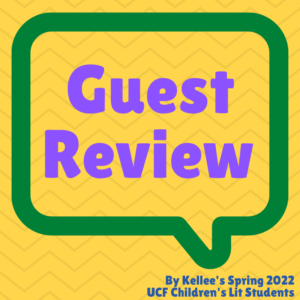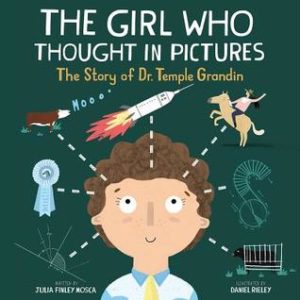Guest Reviewer: Bree, UCF Elementary Education Student
The Girl Who Thought in Pictures: The Story of Dr. Temple Grandin
Author: Julia Finley Mosca
Illustrator: Daniel Rieley
Published March 5th, 2017 by The Innovation Press
Summary: Meet Dr. Temple Grandin—one of the world’s quirkiest science heroes!
When young Temple was diagnosed with autism, no one expected her to talk, let alone become one of the most powerful voices in modern science. Yet, the determined visual thinker did just that. Her unique mind allowed her to connect with animals in a special way, helping her invent groundbreaking improvements for farms around the globe!
The Girl Who Thought in Pictures: The Story of Dr. Temple Grandin is the first book in a brand new educational series about the inspirational lives of amazing scientists. In addition to the illustrated rhyming tale, you’ll find a complete biography, fun facts, a colorful timeline of events, and even a note from Temple herself!
About the Author: Julia Finley Mosca is a copywriter and former journalist who spent more than a decade in Hollywood crafting messages for money. After working with such recognizable brands as Entertainment Tonight, Yahoo!, American Greetings, and JibJab, she landed her most rewarding job yet―mom to one ferociously curious and spunky little girl. The Amazing Scientists series marks Mosca’s debut into the magical world of children’s books.
Review: A picture-book biography in verse introduces Dr. Temple Grandin, a major spokesperson for autism spectrum disorder.
The author employs easy, accessible language and simple rhyme to describe Grandin’s life, including her original misdiagnosis, the doctors’ advice to “send her away,” her mother’s advocacy, her learning to speak, the “new” diagnosis of autism, frustration with her classmates, her first visit to her aunt’s farm that led to her career as an animal specialist, her understanding of her talents, and the importance of her visual memory. The narrative goes on to describe her high school teacher’s support of her interest in science, her first invention (the “squeeze machine,” a self-calming device based on close-quartered enclosures for livestock), her work in treating cattle humanely, her efforts within the autism community, and the public recognition of her unique talents. The author speaks directly and inclusively: “Being DIFFERENT might just / be what makes you so NEAT!
Teachers’ Tools for Navigation: The Girl Who Thought in Pictures is a great mentor text for teaching students important reading comprehension strategies, writing skills, and grammar concepts. All of our book companions come with activities that relate to these subject areas. Check out just some of the skills included in our book companion!
- Practice identifying character traits that describe Temple.
- Practice making personal connections to the book.
- Integrate expository writing by asking students to write explanations for events that happened in the book.
- Allow students to get creative by writing their own version of the book.
- Use examples from the book to teach a lesson on action verbs and adjectives.
- Teach a lesson on contractions.
- Have a class discussion about diversity.
Discussion Questions:
- How will you use your talents and uniqueness to make the world better?
- What do you think it was like to be the victim of teasing for being herself in school?
- What skills would you like to develop that you are already interested in or good at?
- What did you learn from The Girl Who Thought in Pictures or how did she inspire you?
Flagged Passages:
“So here is the lesson: Feeling odd or off beat? Being DIFFERENT might just be what makes you so NEAT! Don’t let doubt hold you back, not one minute more. Stand tall, and like Temple… March right through that door!”
Book Trailer:
Read This If You Love: Inclusion, Diversity, and above all autism and neurodiversity!
Recommended For:
Thank you, Bree, for your review!







looks like great work Julia Finley Mosca.
from 36 year teacher palm beach county , walter mosca